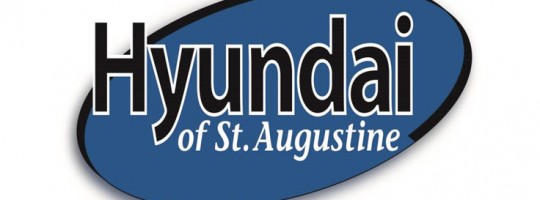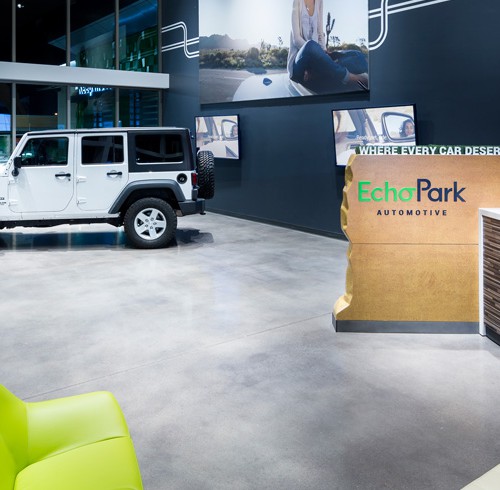Part 2: Q&A With Hyundai Of St. Augustine General Manager, Andrew DiFeo

Part 1: Q&A With Hyundai Of St. Augustine General Manager, Andrew DiFeo
DrivingSales News recently sat down with Andrew DiFeo, the general manager of Hyundai of St. Augustine, which opened in May 2008. In part two of this two-part interview, DrivingSales News sought to learn how DiFeo manages his inventory, in store processes as well his philosophy on recruiting. DiFeo has made a name for himself as a truly innovative dealer who has led his award-winning store using hands-on leadership. The conversation with DiFeo is presented in a Q&A format.
Q: Let’s talk about the CFPB. How do you make sure you’re protecting your dealership, but still generating some revenue in F&I?
DiFeo: We obviously monitor everything that comes out of the CFPB. DrivingSales News can provide updates. NADA emails – they keep the dealer body very abreast of the situations, and also our lending institutions will send out notifications about how we should conduct our business.
We have discussions with our sales management team about how we conduct business regularly. We use an average interest rate for our consumers before their credit gets pulled. We don’t like to pull credit early on in the transaction – until the customer is comfortable with it. We have a very soft sell approach in our dealership and we don’t put a hard sell on getting a customer’s credit upfront. We do ask for it online when we’re working transactions over the Internet. A lot of the time the customer wants exact payments and when we get to exact payments, we want to give an exact interest rate.
As a dealership we’re trying to make revenue more on the F&I products that are of value to the consumer, such as extended warranty, GAP insurance, and prepaid maintenance. There is obviously value to the consumer in the dealership securing the loan and processing it. We look at the revenue side of the F&I business to fall more on the products that provide value to the consumer versus the finance reserve.
Q: What’s your in-store process? How are you keeping the wait time down for the customer and keeping that process a well-oiled machine?
DiFeo: We have the sales department, including F&I and service manager involved in all of our meetings. We really don’t want to have a siloed approach to the dealership. One sales person having a good month doesn’t make a dealership’s month. One department having a good month doesn’t make the dealership’s month. It’s a team effort for the greater good of the organization because the more profitable the dealership is, the more we can invest in training and infrastructure, advertising, compensation and so forth. There’s constant communication between sales people, sales managers and F&I managers about what’s going on in the store or what could be going on in the store.
As far as having appointments coming in – if we already have their credit application over the Internet and we’ve already done their trade appraisal, let’s pre-load as much of that information into the system as possible to reduce wait time. We also try to incorporate as much of the delivery process of the actual vehicle during that short wait time, about 15 to 20 minutes, between the time that somebody says yes to the time they’re talking to a F&I manager.
We have a great process of the turnover from sales to F&I in that the salesperson or sales manager will introduce the customer to the F&I manager on the showroom floor and the F&I interview is conducted on the showroom floor at the salesperson’s desk with the customer, as far as driving habits, their current trade, what products they had on their current trade, gap insurance, warranties so on and so forth. Then, the F&I manager will go back into the office armed with that information, prepare their menu, prepare their value presentation to the customer before they even walk into the F&I office. Our salespeople are also compensated on what F&I products are being sold to the customer. There’s a benefit to them talking lightly about those products. We don’t ask the salespeople to sell the products, but we do want them to mention what products are available and that we are also a carrier of the Hyundai Capital Insurance products. The OEM backed warranties; the OEM backed prepaid maintenance plan, and so on. That’s helped us tremendously, almost doubling our F&I revenues since we switched to the OEM backed products and refined our sales and F&I turnover process.
Q: F&I can be the bottleneck of the process at many dealerships. Have you seen that at other dealerships and how do you conquer that?
DiFeo: That’s definitely a big issue in this industry on busy days. We have to make sure that there’s been an introduction to the service department, the customer’s first service appointment has been scheduled, the customer’s enrolled in Blue Link (Hyundai’s Telematics system,) that the customer’s cellphone is paired to their vehicle through Bluetooth, etc. We try to get as much of the delivery out of the way during that downtime when there’s a wait for F&I.
Q: What’s your recon strategy on used cars?
DiFeo: Obviously, speed to the Internet is the key on your inventory. The quicker you can get your inventory online the better. Ninety percent of our vehicles go through the shop. If a vehicle is really high in miles and just cosmetically does not look like it’s going to make it to our lot, we will wholesale it. With the difficulty to acquire good inventory and with the demand for used cars in every price range, whether it’s $2,000 or $3,000 up to $100,000, we want to let our service department look at every vehicle and within reason recondition those vehicles.
Obviously, for safety and depending on the mileage of the car, if it’s over 100k miles we might not recondition the vehicle mechanically to 100 percent but, we’ll at least know what the car needs, fix any safety issues if we are going to retail the vehicle and then let the consumer know that this car might be priced at $4,000 – it does need about $1,500 worth of work that we didn’t perform. We will perform it for you at a discounted rate or you can buy the car and bring it to your local tech. Obviously we’d like to earn their service.
Every car goes through our recon department and our target date from taking a car in to having it both reconditioned and detailed is three days. When we’re firing on all cylinders, we can hit that three-day mark. When it spikes up to five or six days, we sit down and refocus our efforts. Again, it’s something where our management team works hand-in-hand knowing that speed to the lot and speed to the Internet properly merchandised is the key to a fast turn rate for used cars.
Q: How are you balancing your inventory stock with demand to make sure you keep that turn low?
DiFeo: Pricing, stocking, and merchandising tools provide us with so much data to be able to gauge what’s in demand in our market, what we’re stocking, what’s selling typically, what’s selling slowly, what’s selling at higher gross margins and what’s selling at lower gross margins. We’re able to develop our stocking strategy from that.
Q: What are your inventory turn rates?       Â
DiFeo: On our new cars we typically carry a 60-day or less supply, which is about 25 percent better, sometimes as much as 50 percent better, then the region and the nation. We have less then a 60-day turn on our new cars and we manage that by making sure our inventory, our ordering is done properly. We know what colors and packages will sell quicker. We try to stock the quickest turning inventory. We look at our sales history to determine that. We manage our aged inventory by reviewing it weekly; does it need to be re-priced to move that aged inventory out?
We really try to not have a new car out on our lot over 90 days because the more a new car is on the lot the higher chance for lot damage, for missing keys, for dead batteries, and so on. We really try to turn our new car inventory quickly. As far as our used cars, we hover anywhere between a 24 to 30 day turn. We have a strict no over 60 days in inventory policy for our used inventory. Pretty much, after 30 days that a car has not been sold, we start to look at our exit strategy from both a retail and wholesale perspective. We monitor our prices daily. After 30 days we will post those vehicles to online wholesale auctions. After about 45 days we start to look at our exit strategy for wholesaling the vehicle at auctions or within our dealer network.
Q: What kinds of stats have you seen in terms of setting the first service appointment at the point of sale?
DiFeo: We hover around 90 percent setting up a first service appointment at time of sale, which is about 10 percent higher then what the region and the nation are. We feel like we’re doing a pretty good job there.
Q: How have you put together a successful team? Can you walk us through your hiring and training process?
DiFeo: The model of quick to hire, slow to fire is very commonplace in the automotive business, when it should be the reverse. It should be slow to hire, quick to fire. Not saying that in a negative way, but just set clear expectations for your employees and if they don’t meet those expectations, to part ways with them. It’s a disservice to the employee, the company, your other employees and your consumer base to keep someone around that isn’t working out. If somebody might just not be the right fit for your organization or for the automotive industry, it’s better to part ways with them sooner then later.
Even if we don’t have positions to fill, we’re always prospecting and talking to people in the industry or outside of the industry about finding good people to work with. We found people in the service industry. If you had a great experience at a restaurant, you might give your business card to the waiter or waitress to say, “If you’re ever looking for another opportunity, we’d love for you to join our team.” We’re always looking for people to join our team, so we’re not forced to hire. Sometimes when you’re forced to hire somebody you might make not the best decision there.
We’re always training. We use an online platform to do the training along with our management team conducting that training and we do that in both sales, service and F&I. We’re always looking for training opportunities to send our employees to, whether it be manufacture training opportunities, whether it be guest service skills training or regulations training for our office staff or F&I managers. By doing that, we are investing in our employees and I think that is a testament to our lower turnover rate.
Q: What is your employee turnover rate?
DiFeo: I would say about 25 percent of our sales people turnover, but it’s usually the bottom quarter. We have 16 sales people and I have five managers that have been with us since we opened the business seven years ago. Pretty much, everybody else has tenure of three or four years on my management staff.
Q: How much emphasis do you put on car sales experience versus character and smarts?
DiFeo: We put a lot more emphasis on the character and the person’s ability to learn and be optimistic and have a positive attitude. Also, the use of mobile technology is extremely important. If somebody came to an interview that has a flip phone, they’re probably not the right fit for our organization because from a CRM standpoint, from a marketing standpoint, from a communications standpoint with our customers, everything is mobile today.












Warning: count(): Parameter must be an array or an object that implements Countable in /home/pg4b1yzvrqqo/domains/test.drivingsalesnews.com/html/wp-includes/class-wp-comment-query.php on line 399
You couldn’t have said it better Sean: “They’re looking for jobs that give them a sense of fulfillment or meaning, allow them to be authentic and play to their strengths, offer opportunities for learning and growth, and empower them to take initiative,â€
Thanks for this post. Very educational
Dealers, here is also what you are facing with the M-Gen: Two general types of Millennials: Self-Reliant or Helicopter – Self-Reliant Millennials are “old souls’. Generally, most of these candidates have parents and upbringing that taught them the American Dream promises with a combination of education, hard work, and good behavior, any citizen can move from humble beginnings to at least reasonable success. These candidates are what I call Self-Reliant because their parents have dispelled the myths of luck and instant gratification. They have great personalities, great work ethics, are intelligent, tech savvy, dependable, and work hard and long hours (some I meet work two jobs). All the attributes we are ALL looking for! However, Self-Reliant Millennials are NOT your challenge to manage.
The other side of this coin and the MAJORITY are the Helicopter type candidates. Some parents actually come to the job interviews with them. Because their parents have stepped in for them all their lives, most of these Millennials believe that the average, if not below average people, become rich and famous for their debauchery, bestiality or just plain sex tapes (Jersey Shore, Bad Girls Club, Real World, Kim Kardashian). These Millennials think: If people like these become millionaires, why can’t I?
So with the above in mind, is your dealership and management style out-of-date with current and coming trends? Is it time to rethink your strategy and move from our old style of rough and tumble and the strongest will survive (like I was brought up in), to hiring young blood managers that can coddle and mentor their protégés. If you can’t see yourself in that change, you may be out of date as our wonderful long serving Ruth Bader Ginsberg Supreme Court Justice.
Many Dealers, GMs, and dealership Managers have told me when facing this dilemma: “Might be time for me to retire and hang it upâ€.
Only time will tell …….